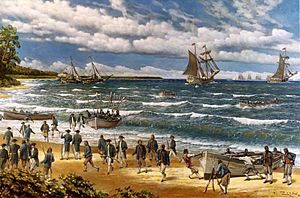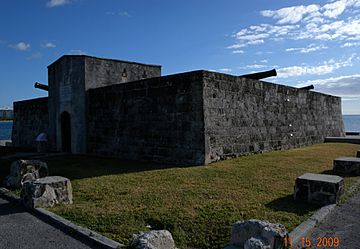Raid of Nassau facts for kids
Quick facts for kids Raid of Nassau |
|||||||
|---|---|---|---|---|---|---|---|
| Part of the American Revolutionary War | |||||||
 New Providence Raid, March 1776, V. Zveg |
|||||||
|
|||||||
| Belligerents | |||||||
| Commanders and leaders | |||||||
| Strength | |||||||
| 2 frigates 2 brigs 1 schooner 1 sloop |
2 forts | ||||||
The Raid of Nassau happened on March 3–4, 1776. It was a naval attack and landing by American forces against the British port of Nassau, Bahamas. This event took place during the American Revolutionary War.
The main goal of the raid was to get more gunpowder for the American forces. The Americans successfully took over two forts and a lot of military supplies. After the raid, they sailed back to New England. On their way, they had a short fight with a British ship.
During the American Revolutionary War, the American Patriot forces really needed more gunpowder. To help with this, the Second Continental Congress told an American fleet, led by Esek Hopkins, to patrol the coastlines. Hopkins might have also received secret orders to attack Nassau. This was because gunpowder that had been taken from Virginia was sent there.
The American fleet left Cape Henlopen, Delaware, on February 17, 1776. They arrived in The Bahamas on March 1. Two days later, 200 Continental Marines landed. They quickly took Fort Montagu. However, they did not immediately move into the town where the gunpowder was kept.
The British Governor, Montfort Browne, quickly loaded most of Nassau's gunpowder onto ships. These ships then sailed away to St. Augustine. On March 4, the marines captured Nassau.
The Americans stayed in Nassau for two weeks. They took all the military supplies they could find. Then, they left. On April 6, the fleet fought a British ship called HMS Glasgow. They did not manage to capture it. After this, they returned to New London, Connecticut. Even though the raid was a success, not capturing Glasgow and some complaints from the crew led to problems for Hopkins. He was later removed from his command in 1778.
Contents
Why the Raid on Nassau Happened

When the American Revolutionary War began in 1775, there was a big need for gunpowder. Lord Dunmore, who was the British governor of Virginia, ordered the Royal Navy to take gunpowder from Williamsburg. He had it moved to New Providence island in the Bahamas. This was to stop American Patriots from getting it.
The British governor of the Bahamas, Montfort Browne, was warned in August 1775. British general Thomas Gage told him that Americans might try to seize the gunpowder in the Bahamas.
The Continental Army desperately needed gunpowder. So, the Second Continental Congress decided to send a naval group to Nassau. Their goal was to capture the military supplies stored there. The official orders for Esek Hopkins, who led the mission, were to patrol the coasts. But he might have also received secret instructions to attack Nassau.
Hopkins told his captains to meet at Great Abaco Island in the Bahamas. This was before they sailed from Cape Henlopen, Delaware, on February 17, 1776.
Hopkins' fleet included several ships: Alfred, Hornet, Wasp, Fly, Andrew Doria, Cabot, Providence, and Columbus. They also carried 200 Continental Marines. These marines were led by Samuel Nicholas.
Strong winds caused Fly and Hornet to separate from the fleet. Hornet had to go back for repairs. Fly rejoined the fleet later, after the raid. Hopkins decided to continue the mission. He knew that many British ships were in port because of the bad weather.
Preparing for the Attack
Governor Browne got more news in late February. He heard that an American fleet was gathering off the Delaware coast. But he did not seem to do much to get ready for a defense. Nassau's harbor had two main forts to protect it. These were Fort Nassau and Fort Montagu.
Fort Nassau was in the town of Nassau. But it was not very good at defending against attacks from the sea. Its walls were not strong enough for its 46 cannons. So, Fort Montagu was built in 1742. It was on the eastern side of the harbor and watched over the entrance. When the raid happened, Fort Montagu had 17 cannons. Most of the gunpowder was kept at Fort Nassau.
Hopkins' fleet arrived at Great Abaco Island on March 1, 1776. They captured two Loyalist-owned small ships called sloops. The owners were forced to help guide the American ships. A local ship captain named George Dorsett traveled from Abaco to Nassau. He told Governor Browne that the American fleet was nearby.
The American landing force moved to the two captured sloops and the ship Providence. This happened the next day. They planned to attack Nassau. The main fleet stayed back. The three ships with the landing force were supposed to enter Nassau's port at dawn on March 3. They wanted to take control of the town before anyone could raise the alarm.
The Battle Begins
The plan to land at daybreak did not work. The alarm was raised in Nassau when the three American ships were seen in the morning light. Governor Browne was woken up. He ordered four cannons at Fort Nassau to be fired to alert the local soldiers. Two of these cannons broke when they were fired.
At 7:00 a.m., Browne talked with one of his advisors, Samuel Gambier. They thought about moving the gunpowder off the islands on a fast ship called Mississippi Packet. They decided not to do it at that moment. But Browne did order 30 mostly unarmed soldiers to go to Fort Montagu. Then he went back to his house to get ready.
Landing and Taking Control
When the Americans heard the cannons from Fort Nassau, they knew their surprise was gone. They stopped their first attack plan. The ships then met up again in Hanover Sound, about six miles east of Nassau. Hopkins held a meeting, and they made a new plan.
Some stories say that Hopkins' lieutenant, John Paul Jones, suggested a new landing spot and led the attack. But Jones did not know the local waters well. It is more likely that the landing force was led by Thomas Weaver, who knew the area.
The landing force was made bigger with 50 more sailors. The three ships, with Wasp helping to protect them, went to a spot south and east of Fort Montagu. They landed there without any resistance between 12:00 and 2:00 p.m. This was the first time what would become the United States Marine Corps made a landing from the sea.
A British lieutenant named Burke led a small group from Fort Montagu to see what the Americans were doing. Since he was greatly outnumbered, he sent a white flag to ask what they wanted. He learned that their goal was to take the gunpowder and military supplies.
Meanwhile, Governor Browne arrived at Fort Montagu with 80 more local soldiers. When he learned how large the American force was, he ordered three of the fort's cannons to be fired. Then he took most of his men back to Nassau. He went back to the governor's house. Most of the local soldiers also went home instead of trying to fight the Americans.
Browne sent Burke to talk with the Americans a second time. He wanted Burke to "wait on the command officer of the enemy to know his errand." The firing of Montagu's cannons had worried Nicholas, the American commander. But his men had now taken over the fort. He was talking with his officers when Burke arrived. They told Burke again that they were there to take the powder and weapons. They said they were ready to attack the town.
Burke brought this news back to Browne around 4:00 p.m. Nicholas and his force, which included 200 marines and 50 sailors, stayed at Fort Montagu that night. They did not move further into Nassau. Browne held a meeting that evening. They decided to try to move the gunpowder.
At midnight, 162 barrels of gunpowder were loaded onto Mississippi Packet and HMS St John. At 2:00 a.m., these ships sailed out of Nassau harbor. They were headed for St. Augustine, Florida. This was possible because Hopkins had not placed any ships to guard the harbor entrance. The American fleet was safely anchored in Hanover Sound.
Nicholas' marines entered Nassau the next morning without any fighting. They were met by a group of town leaders who offered them the town's keys.
The Journey Back Home
Hopkins and his fleet stayed in Nassau for two weeks. They loaded as many military supplies as their ships could hold. This included the remaining 38 barrels of gunpowder. He also used a local sloop, Endeavour, to carry some of the items. Governor Browne later complained that the American officers drank most of his alcohol. He also wrote that he was taken in chains like a "felon" when he was arrested and brought onto the ship Alfred.
While they were in Nassau, the ship Fly arrived. Its captain reported that it and Hornet had gotten tangled together. Hornet was badly damaged. On March 17, the fleet sailed for Block Island off Newport, Rhode Island. They took Browne and other British officials with them as prisoners of war.
The trip back was calm until the fleet reached the waters near Long Island. On April 4, they found and captured a British ship called HMS Hawk. The next day, they captured Bolton. This ship was full of supplies, including more weapons and powder.
The fleet finally met resistance on April 6. They came across HMS Glasgow, a British warship. In the fight that followed, the Glasgow was outnumbered but managed to escape. It badly damaged the American ship Cabot. The captain of Cabot, Hopkins' son John Burroughs Hopkins, was wounded. Eleven other American sailors were killed or wounded. The American fleet sailed into the harbor at New London, Connecticut, on April 8.
What Happened After the Raid
At first, Hopkins was praised for the successful raid. But not capturing Glasgow and complaints from the crew led to problems for him. As a result, the captain of Providence was removed from his command. John Paul Jones was given command of Providence. Jones had done well in the fight with Glasgow. He then became a captain in the Continental Navy. He went on to fight in several naval battles off Nova Scotia.
Some members of Congress did not like how Hopkins shared the captured goods. He also did not follow his orders to patrol the Virginia and Carolina coasts. Because of this, the Continental Congress criticized him. After more mistakes and accusations, Hopkins was removed from the navy on January 2, 1778. He had spent the last two years stuck in Narragansett Bay because of the British.
Governor Browne was later exchanged for an American general named William Alexander. Alexander had been captured at the Battle of Long Island. After he returned, Browne was heavily criticized for how he handled the whole situation.
Nassau remained not very well defended. It was threatened by another American attack in January 1778. It was then captured by Spanish forces in 1782. But it was recaptured by Loyalists the next year. The 1783 Treaty of Paris, which ended the war, confirmed that the islands belonged to Britain.
The U.S. Navy ship USS Nassau (LHA-4) is named after this battle. The ship USS Nicholas (FFG-47) is named after Samuel Nicholas.
See also



